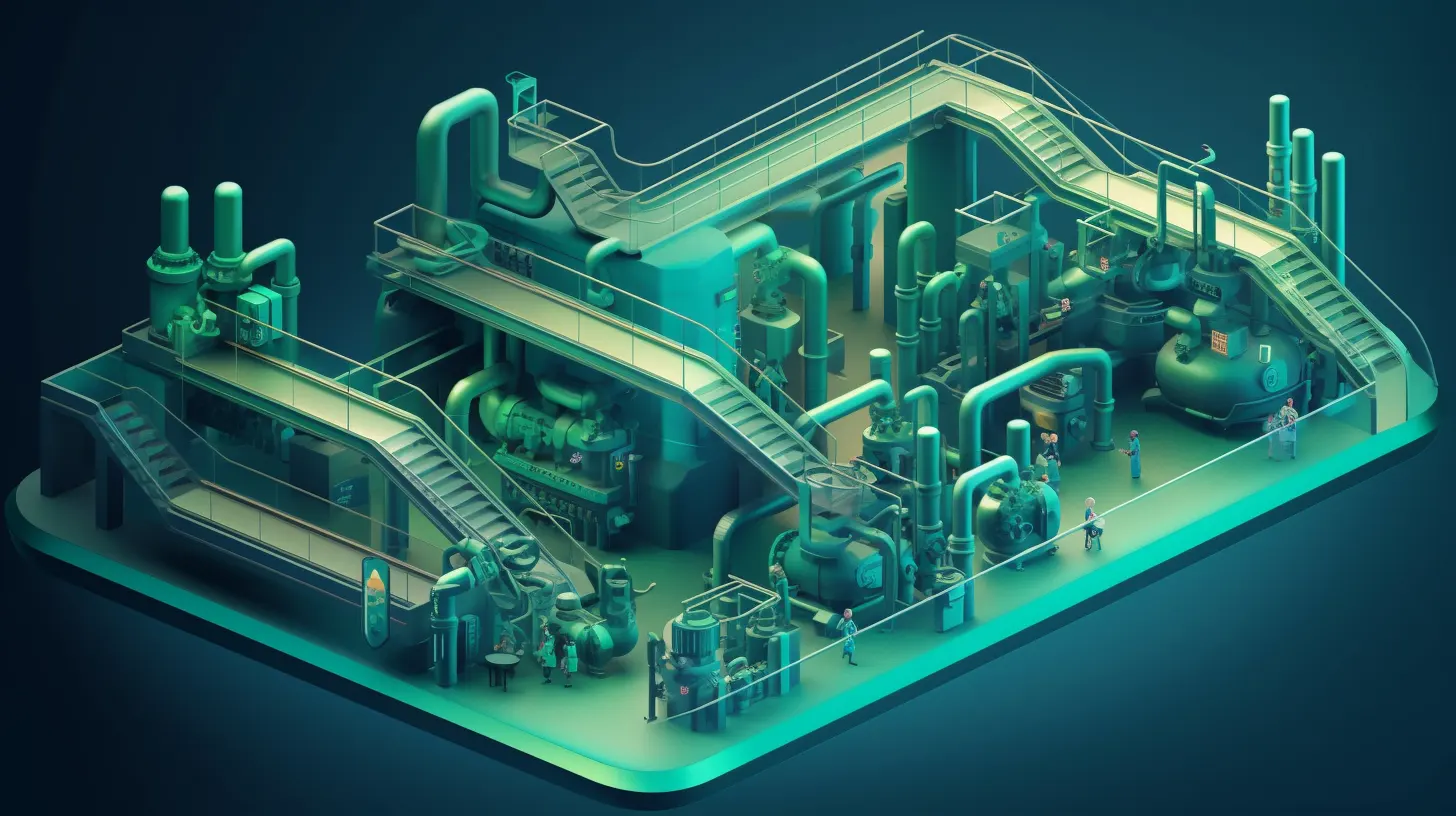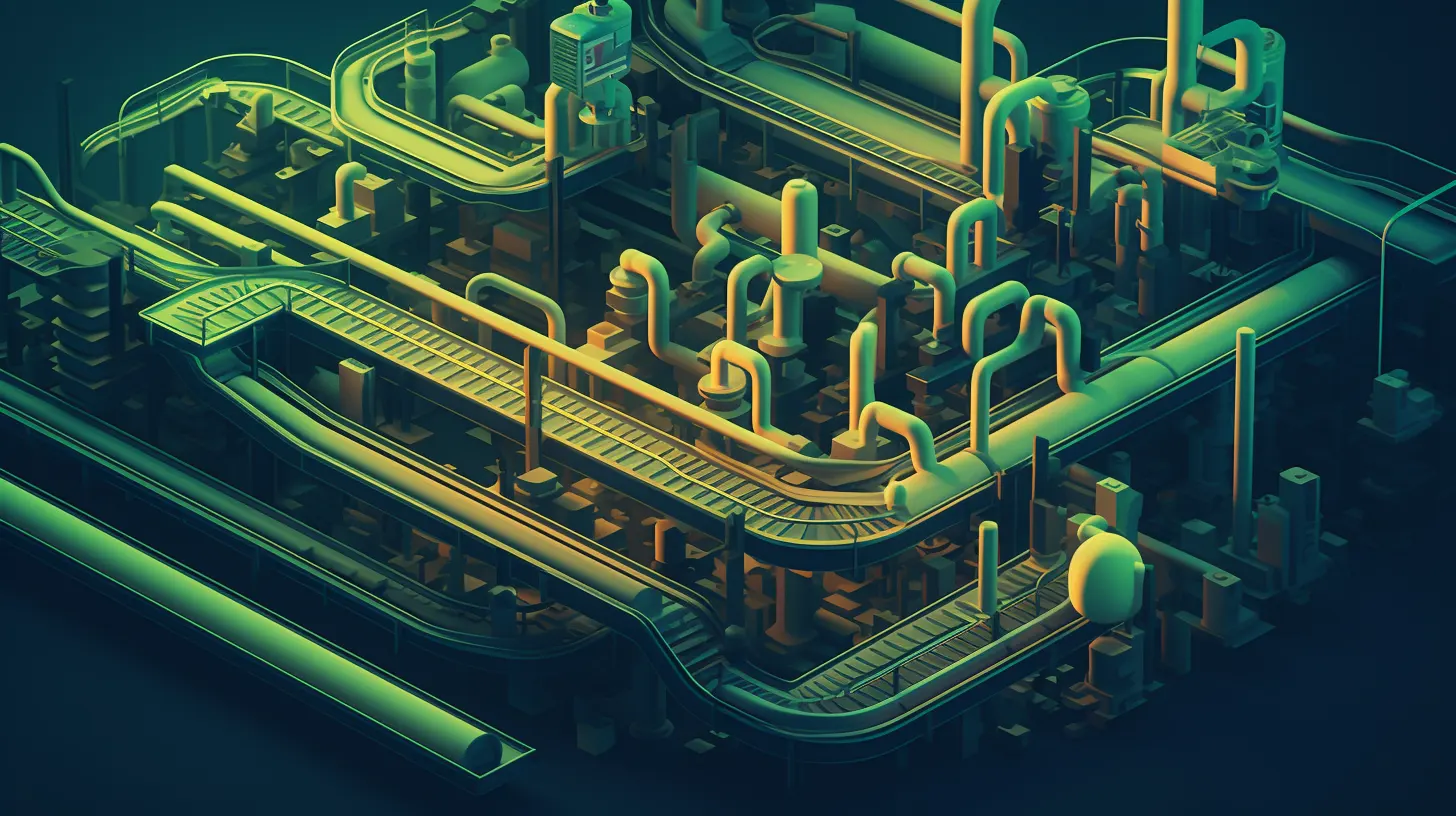This article provides an overview of Key Performance Indicators (KPIs) and their role in lean manufacturing. KPIs are measurable values that show how effectively a company is achieving its key business goals. In lean manufacturing, KPIs typically focus on productivity, quality, efficiency, and cost.
The article discusses different types of KPIs including performance KPIs, quality KPIs, efficiency KPIs, and cost KPIs. It emphasizes the importance of using KPIs for continuous improvement - regularly measuring and analyzing them to identify areas for improvement in manufacturing processes.
The article also covers tools for tracking and analyzing KPIs, provides examples from Toyota and Intel, and explores future trends like the use of AI, machine learning, and predictive analytics with KPIs. Overall, the piece highlights how critical KPIs are for measuring success and driving improvement in lean manufacturing.
Introduction to Lean Manufacturing
Lean Manufacturing or Lean Manufacturing is more than just a buzzword in today's industrial sector. It represents a deeply rooted philosophy, a systematic method for minimizing waste in a production system without sacrificing performance. Inspired by the Toyota Production System, the concept is focused on creating more value for customers with fewer resources.

It is about making the most efficient use of resources to meet customer needs. This efficiency is achieved through the steady elimination or reduction of "muda" (Japanese for "waste" or any activity that consumes resources without adding value) in the processes of design, production, distribution, and customer service.
This approach reduces costs and increases profits, improves quality, reduces delivery time, and increases customer satisfaction.
The Purpose and Importance of Measuring Success in Lean Manufacturing
In lean manufacturing, the measure of success is not only the end product or profit margin. It's about the processes that lead to the end product, how they can be improved, and how they help eliminate waste and create value.

The focus is improving workflow, reducing waste, and maximizing value creation. This requires a deep understanding of the manufacturing process and a commitment to continuous improvement.
The ability to measure success in lean manufacturing is critical. This allows the organization to understand how well they are implementing their strategies and where improvements can be made.
It provides a clear picture of the current state of operations and helps identify areas where waste can be reduced, and efficiency can be improved. Without measurement, it is impossible to know whether a process is improving or not, and it is impossible to determine the root causes of problems.
Understanding Key Performance Indicators (KPIs)
Key performance indicators (KPIs) are important tools for measuring the success of lean manufacturing. KPIs are measurable values that show how effectively a company achieves its key business goals.

In lean manufacturing, KPIs typically focus on productivity, quality, efficiency, and cost. They provide insight into an organization's performance and help identify areas for improvement.
The key to choosing effective KPIs is to align with your strategic goals and objectives. They must be relevant, measurable, actionable, and timely.
They should be closely related to customer satisfaction and bottom lines. KPIs that do not align with strategic objectives may waste effort and resources, while KPIs that are not measurable or actionable may not provide useful information.
General KPIs for Lean Manufacturing
Lean manufacturing typically uses multiple KPIs. Some of the most popular include:
Overall Equipment Effectiveness (OEE): Measures how well a manufacturing unit performs relative to its design capacity when scheduled to run. This powerful metric combines equipment availability, operational efficiency, and quality levels into a single measure.
First Time Through (FTT): This KPI measures the percentage of products produced that meet quality standards and do not need to be reworked. This is an indicator of quality and efficiency. A high FTT indicates that the manufacturing process is efficient and effective, while a low FTT may indicate problems with quality control or process design.
Cycle time: Cycle time determines the average product production time.
Inventory Turnover: This KPI measures how often a company's inventory is sold and replaced over a period. It is a measure of how effectively a company manages its inventory. A high inventory turnover indicates that a company is selling its products quickly, indicating strong sales or efficient inventory management. On the other hand, low inventory turnover may indicate overstocking or problems with sales or inventory management.
Detailed overview of key performance indicators
Performance KPIs
Performance KPIs are critical in lean manufacturing as they measure the efficiency of manufacturing processes. They reflect how well resources are used to produce output.

These KPIs can provide insight into labor utilization, equipment utilization, and process design efficiency. They can help identify areas where productivity can be improved and waste reduced. Examples include:
Units per hour of work: This KPI calculates how many units are produced per hour on average. This is an indicator of labor productivity. A high value for this KPI indicates high labor productivity, while a low value may indicate an inefficient use of labor or process design.
Production Downtime: This KPI tracks when manufacturing processes are idle without producing any units. This may be due to equipment failure, lack of materials, or other issues. Downtime is a form of wastage as it represents resources that are being used inefficiently. Reducing downtime can improve productivity and reduce costs.
Quality KPIs
Quality KPIs measure the standards and reliability of a manufacturing process. Maintaining high quality is central to lean manufacturing, as defects lead to wastage and rework, increasing costs and delaying delivery.

These KPIs provide insight into the effectiveness of quality control processes and can help identify areas where quality can be improved. Here are some examples:
Defect Density: This KPI measures the number of defects in a product or process per unit of measure. It is a measure of the reliability and quality of the manufacturing process. A high defect density can indicate problems with quality control or process design, while a low defect density indicates high process quality.
Rework Rate: This KPI calculates the percentage of products that needed rework because they didn't meet quality standards the first time. Rework is a form of waste, representing additional resources spent on fixing defects. A high level of refinement can indicate problems with quality control or process design, while a low level indicates a high process quality.
Efficiency KPIs
Performance KPIs measure the effectiveness of your processes and how well they convert inputs into outputs. They provide insight into resource efficiency and process design.

These KPIs can help identify areas where efficiency and waste can be reduced. These include:
Cycle Time: As mentioned earlier, this KPI measures the total time it takes to complete a process from start to finish. It gives insight into the efficiency of the manufacturing process and supply chain. A long cycle time can indicate inefficiency, while a short cycle time can indicate a highly efficient process.
Switchover Time: This KPI measures the time it takes to switch a manufacturing process or line from one product to another. It is a measure of the flexibility and efficiency of a manufacturing process. Long setup times can indicate inefficiency, while short setup times indicate process flexibility and efficiency.
Cost KPIs
Key cost performance indicators are critical to understanding the financial performance of manufacturing processes. They allow you to track how much your products cost to produce and where your money goes.

By tracking these costs, you can identify areas where you can reduce waste and improve profitability. These include:
Cost of Goods Sold (COGS): This KPI measures the direct costs of producing goods the company sells. This includes raw materials and direct labor costs associated with producing goods. It does not include indirect costs such as distribution and sales costs. A high COGS may indicate high production costs that may affect profitability. Low cost, on the other hand, may indicate efficient manufacturing processes.
Waste Cost: This KPI measures the cost associated with waste, including scrap materials, rework, and overproduction. Waste is a form of inefficiency, and reducing waste can lead to cost savings and increased profitability. A high waste value may indicate a high level of waste, which can affect profitability. On the other hand, low waste costs may indicate efficient processes and efficient waste management.
The Role of KPIs in Continuous Improvement
Continuous improvement is central to lean manufacturing, and KPIs are critical. It is an effort to improve products, services, or processes. These efforts may simultaneously aim for "incremental" or "breakthrough" improvements over time.

In lean manufacturing, continuous improvement means constantly striving to reduce waste and improve efficiency, quality, and customer satisfaction. This requires an understanding of the current state, a vision of the future state, and a method for managing the changes needed to achieve the future state.
KPIs act as a feedback mechanism in this process. Companies can regularly measure and analyze KPIs to identify areas of their operations that need improvement.
They provide valuable insight into whether the changes implemented as part of lean bring the company closer to achieving its goals. They help identify trends over time and track progress toward goals.
For continuous improvement to be effective, it is important to have a culture that supports it. This requires leadership commitment, employee engagement, and open communication. It is also important to celebrate successes and learn from mistakes.
Tracking and Analysis Methods
In the digital age, numerous tools and software can be used to track and analyze KPIs. These tools collect data from various sources, analyze the data to gain insights, and present the data in an easy-to-understand format, such as dashboards or reports. They provide a real-time overview of the performance of manufacturing processes, enabling timely decision-making and rapid action.
One of the most common methods is Manufacturing Execution Systems (MES). These systems provide real-time information to help you monitor performance and identify areas for improvement. They integrate with other systems such as ERP and SCM to provide a holistic view of manufacturing operations.
Another method is to use enterprise resource planning (ERP) systems. These systems integrate various business processes to provide a comprehensive view of the business that can help track and analyze KPIs. They include modules for inventory management, production planning, sales and marketing, finance, human resources, and more.
![]()
Data analysis tools can also analyze KPI data and provide insights. These tools use statistical methods to identify patterns and trends in data that can provide valuable information for decision-making.
In addition to these tools, it is also important to have a culture that values evidence-based decision-making. This includes training employees on how to use these tools and interpret data and encouraging them to use the data to make decisions.
Practical examples
Toyota
Toyota, which inspired the concept of lean manufacturing, is a prime example of the successful use of KPIs. An automaker has a set of key performance indicators closely related to its business objectives. These include key performance indicators, quality, efficiency, and cost.
For example, one of the key indicators is the number of defects per car. By tracking this KPI and implementing continuous improvement initiatives, the company has significantly reduced the number of defects in its vehicles, resulting in increased customer satisfaction and reduced costs.
Another critical KPI is production downtime. The firm improved production efficiency and reduced costs by monitoring this KPI and implementing measures to reduce downtime.
Intel
Intel, the world's largest semiconductor chip manufacturer, is another example of the successful use of KPIs in lean manufacturing. Intel uses a range of KPIs to measure the performance of its manufacturing processes, including performance, quality, efficiency, and cost KPIs.
These KPIs provide valuable insight into the performance of Intel's manufacturing processes, helping you identify areas for improvement.
For example, Intel tracks profitability, the percentage of chips that meet quality standards. Intel has increased profitability by monitoring this KPI and implementing continuous improvement initiatives that result in improved product quality and lower costs.
Another important KPI for Intel is cycle time. Intel has increased production speed and reduced inventory costs by monitoring this KPI and implementing measures to reduce cycle times.
Future Trends in Lean KPIs
The future of Lean KPIs is expected to depend on technological advances. The rise of Industry 4.0 and the Industrial Internet of Things (IoT) leads to smart factories where machines are connected and share data. This will enable real-time tracking of a wider range of KPIs, providing even more insight into manufacturing processes.
One important trend is using artificial intelligence (AI) and machine learning (ML) in data analysis. These technologies allow you to quickly and accurately analyze large amounts of data, uncovering patterns and trends that human analysts might miss.
In addition, predictive analytics, a branch of advanced analytics that uses both new and historical data to predict future activity, behavior, and trends, is also expected to play a larger role in lean manufacturing. Predictive analytics can help identify problems before they become problems, allowing you to make proactive decisions.

Moreover, as more companies adopt sustainability as a core business strategy, sustainability KPIs will likely become more mainstream. These KPIs can measure manufacturing processes' environmental impact, such as energy use, water use, and waste generation.
Conclusion
In conclusion, KPIs are critical to measuring success in lean manufacturing. They provide valuable information about manufacturing processes' efficiency, quality, and cost-effectiveness, helping identify improvement areas. Companies can regularly measure and analyze KPIs to improve operations, reduce waste, and add value to customers.

The future of lean manufacturing will be driven by technological advances that provide even more room for improvement and success. As the manufacturing industry develops, companies that effectively use key performance indicators and constantly improve will have every chance of success.
FAQ
How can KPIs be used to identify bottlenecks in the manufacturing process?By tracking KPIs such as cycle time, production downtime, and first pass yield at each stage of the manufacturing process, companies can pinpoint specific areas where bottlenecks are occurring. This allows them to focus improvement efforts on those stages to increase overall efficiency.
What role do employee engagement and training play in the successful use of KPIs?Employee engagement and training are crucial for the effective use of KPIs. Employees need to understand the importance of KPIs, how to measure and interpret them, and how to use the insights gained to drive improvements. Companies should invest in training programs and foster a culture of continuous improvement.
How often should KPIs be reviewed and updated?The frequency of KPI review and updating depends on the specific KPI and the dynamics of the business. Some KPIs may need to be monitored daily or weekly, while others can be reviewed monthly or quarterly. The key is to ensure KPIs remain relevant and aligned with business objectives.
Can KPIs be used to benchmark performance against competitors?Yes, KPIs can be used for benchmarking, but it requires access to industry data or collaboration with other companies. Benchmarking helps identify areas where a company is lagging behind competitors and can drive performance improvements to close those gaps.
How can visual management techniques be used with KPIs?Visual management techniques like dashboards, scorecards, and Andon boards can make KPIs more accessible and understandable for employees at all levels. These visual tools provide real-time updates on KPI performance, making it easier to spot trends and take corrective actions quickly.
What are some common pitfalls to avoid when implementing KPIs?Some common pitfalls include selecting too many KPIs, choosing KPIs that are not aligned with business objectives, setting unrealistic targets, and failing to communicate the importance of KPIs to employees. It's important to start with a few critical KPIs, ensure they are relevant and achievable, and engage employees in the process.
How can KPIs be used to drive innovation in manufacturing?By tracking KPIs related to new product introduction, R&D spending, and employee suggestions, companies can measure and encourage innovation. KPIs can also be used to track the performance of innovation initiatives and ensure they are delivering the desired results.
What is the future of KPIs in the era of Industry 4.0 and big data?With the advent of Industry 4.0 and big data, KPIs will become even more important. Advanced analytics and machine learning will enable companies to process vast amounts of data in real time, providing deeper insights into performance. This will allow for more predictive and prescriptive analytics, enabling companies to anticipate problems and take proactive measures.




